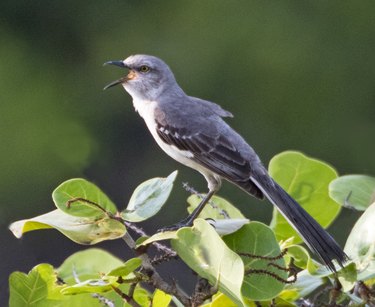
Like young Scout in Harper Lee's To Kill a Mockingbird, many folks believe it's a sin to harm or try to get rid of mockingbirds (Mimus polyglottos). Some even equate killing a mockingbird to any form of violence perpetrated against a harmless, innocent individual, such as the racial or social injustices depicted in the novel. Many people love and feed the clever birds because they enjoy their cheery songs and cunning mimicry of other bird calls.
However, they can be raucous, territorial, and aggressive, especially while raising young, and mockingbirds may attack other wildlife, humans, and pets. They peck out the eyes of prowling snakes and attack hawks, ravens, and cats. It's small wonder that some folks perceive mockingbirds as less than ideal neighbors.
Video of the Day
Video of the Day
Legal Implications of Mockingbird Elimination
It turns out that killing a mockingbird isn't only a sin; it's also a crime. Native birds, like mockingbirds and most other United States birds, are protected by individual state laws and the federal Migratory Bird Treaty Act of 1918. This makes it illegal to kill, harm, or relocate the birds, their nests, their babies, or their eggs without a permit. It's also illegal to possess them, so you can't keep one as a pet. It's against federal law to harass or harm them in any way while they're nesting and raising young. So, once they start mating and nesting, you're required to leave them unmolested until after their babies leave the nest.
Timing Is Critical
When attempting to get rid of mockingbirds, timing becomes an issue once they begin to breed and raise their families. During this time, it's illegal to harass or interfere with homemaking activities.
Male mockingbirds begin establishing their territories in February, when they seek mates. Breeding occurs from April through July, but it can run from January through August. Nest building, egg incubation, and fledging cycles run 23 to 25 days, and pairs raise two or three broods annually.
Take Away Their Reasons
To get rid of mockingbirds, remove their reasons for being there. While it's illegal to harm or kill native songbirds at any time, it's perfectly fine to make them feel unwelcome as long as they're not mating, nesting, or rearing their young. Otherwise, you are completely free to get rid of mockingbirds using any nonlethal means, so release your inner 12-year-old and prepare to pester, torment, harass, and annoy.
Discourage mockingbirds from your property by trimming shrubs and pruning trees often. Wild birds feel more secure if there are plenty of places to dive for cover when danger threatens. You'll also deprive them of nighttime accommodations by removing potential roosting areas. Collect and remove sticks and branches from the ground after pruning and rake up grass clippings right after mowing, as this stuff can serve as nesting materials.
Eliminate drinking and bathing opportunities by removing any standing water on the property. Disable or cover birdbaths. Drain the kiddie pool right away when the youngsters are finished with it. Empty any other containers holding water.
Mockingbirds mainly eat insects in the summer, so institute aggressive pest control to reduce their food supply. Come fall, however, mockingbirds switch to eating mainly fruit, so keep fresh fruits picked from your trees and bushes and don't let fallen fruits remain on the ground. Cover fruiting plants with bird netting to keep mockingbirds away from the fruits as they ripen.
Scare and Annoy Them
Be persistent and patient. The key to successfully managing any nuisance bird species is to use an assortment of repelling techniques simultaneously. It may take days or weeks of harassment to produce positive results in stubborn mockingbirds who are intent on sticking around. Just keep at it and eventually, they'll get sick of you and your shenanigans and seek more peaceful digs elsewhere.
Purchase owl or hawk decoys or make cardboard cutouts of the predators and scatter them near the birds' proclaimed territory. Mockingbirds are extremely wary of hawks and owls, making the fakes highly effective. Cover cardboard cutouts with clear tape to protect them from the weather. Move the "predators" a couple of times daily so the mockingbirds don't learn that they're harmless.
Mockingbirds dislike bright lights, and many people report great success using motion-activated lights. These ultrasonic devices detect the birds and can be set to emit noise, lights, or both, and some models can also be set to shoot jets of water at the intruder. Just poke the gizmo into the ground or mount it in the tree where the mockingbirds are roosting at night, set it, and move it to a new location once daily.
Create plenty of noise whenever possible without annoying your neighbors. Bang on metal pots, yell at their territory, and blow a whistle. Place a radio outside and crank it up.
Tip
If your mockingbirds become too difficult for you to manage, contact a local wildlife professional. Be prepared to resume your scare and annoy tactics should the birds return later in the season.